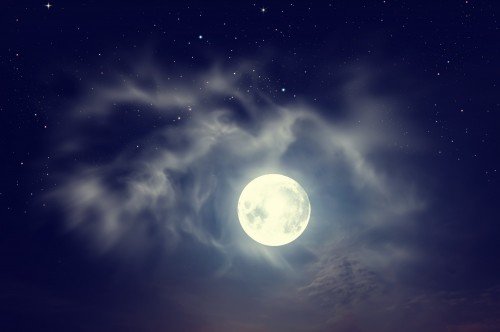Did anyone stay up to catch a glimpse of last week’s full moon? In between the clouds and a chilly atmosphere the lunar sphere could be seen peeking down on the Eastern Shore, illuminating the quiet waterways. However this seemingly harmless celestial orb has been cited for having superstitious powers as well as ties to folklore throughout the centuries.
The full moon occurring in January is also referred to as the Wolf Moon. The name originates from Native American legends that allude to January as a time of starvation in the wilderness. Because of the lack of food, wolf packs would gather around Native American settlements and howl out of hunger. Other full moon names that come from Native American legends include April’s Full Fish Moon, marking the time when shad swam upstream to spawn, June’s Full Strawberry Moon, which marked when the delicious fruit was ready to pick, and the Full Corn or Harvest Moon in October, which represented the time when the corn was ripe.
In European traditions, the January full moon is called the Old Moon or the Moon after Yule. Although we typically associate Yuletide customs with Christmas, it is actually part of Gaelic paganism. In the early days before Northern Europe was introduced to Christianity, these ancient people celebrated the Winter Solstice, or Yule, in late December to mark the days growing longer.
Full moons have also been rumored to have the power to invoke insanity and insomnia. The word “lunacy” comes from this same association of the moon with crazy behavior. There have been studies done recently to try to either prove or dismiss this theory but there has been no conclusive evidence either way. Some studies have proved that people receive less sleep during a full moon, while other studies attempt to prove that more hospital visits and dog bites occur during a full moon. While some research did give merit to this theory, others showed that there were fewer instances of these happenings.
Of course there are also tales of werewolves howling at the full moon. In one piece of folklore, if someone sleeps with the light of the full moon on their face, they will be transformed into this carnivorous creature.
A full moon also affects the tides of our coastal waterways. During a Full or New Moon, high tides reach farther up our beaches than during other lunar phases. This phenomenon is called the spring tide, not because of the season but because the water springs higher than usual. Ocean life is also affected by the full moon; some species of coral only spawn during this lunar phase.
During any phase of the moon, we always enjoy a brisk winter walk with the dog under the stars or a moonlit drive after dinner. Being on the Shore and away from major metropolitan centers provides great star gazing opportunities, allowing us to especially enjoy the celestial beauty in our area. A drive down towards Assateague, a stroll along Ocean City’s boardwalk, or a trip to the Delaware seashore are all great places to take in the light of the full moon.









